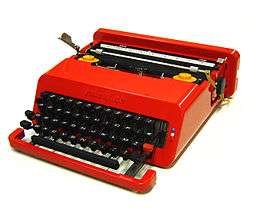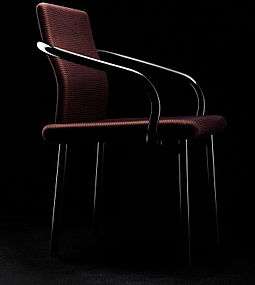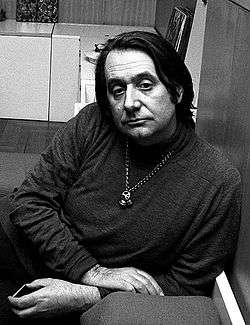Ettore Sottsass
| Ettore Michealo Sottsass | |
|---|---|
|
Ettore Sottsass in 1969 | |
| Born |
14 September 1917 Innsbruck, Austria-Hungary |
| Died |
31 December 2007 (aged 90) Milan, Italy |
| Nationality | Italian |
| Occupation | Architect |
| Practice | Sottsass |
| Buildings |
Mayer-Schwarz Gallery Beverly Hills, California |
| Design |
Olivetti Valentine typewriter emeco.net/productline/nine-0.html Nine-0 Chair |
Ettore Sottsass (14 September 1917 – 31 December 2007) was an Italian architect and designer of the late 20th century. His body of designs included furniture, jewellery, glass, lighting and office machine design.
Early career
_-_BEIC_6365848.jpg)
Sottsass was born on 14 September 1917 in Innsbruck, Austria, and grew up in Milan, where his father was an architect.
He was educated at the Politecnico di Torino in Turin and graduated in 1939 with a degree in architecture. He served in the Italian military and spent much of World War II in a concentration camp in Yugoslavia. After returning home in 1948, he set up his own architectural and industrial design studio in Milan.

In 1949 Sottsass married Fernanda Pivano, a writer, journalist, translator and critic. They divorced in 1970, and in 1976 Sottsass married Barbara Radice, an art critic.[1]


In 1956, Ettore Sottsass began working as a design consultant for Olivetti, designing office equipment, typewriters, and furniture. Sottsass was hired by Adriano Olivetti, the founder, to work alongside his son, Roberto. There Sottsass made his name as a designer who, through colour, form and styling, managed to bring office equipment into the realm of popular culture.[2] Sottsass, Mario Tchou, and Roberto Olivetti won the prestigious 1960 Compasso d’Oro with the Elea 9003, the first Italian mainframe computer. In 1968, the Royal College of Art in London granted Sottsass an honorary doctoral degree.[3]
Throughout the 1960s, Sottsass travelled in the US and India and designed more products for Olivetti, culminating in the bright red plastic portable Valentine typewriter in 1970, which became a fashion accessory.[2] Sotsass described the Valentine as "a brio among typewriters." Compared with the typical drab typewriters of the day, the Valentine was more of a design statement item than an office machine.
While continuing to design for Olivetti in the 1960s, Sottsass developed a range of objects which were expressions of his personal experiences traveling in the United States and India.[4] These objects included large altar-like ceramic sculptures and his "Superboxes", radical sculptural gestures presented within a context of consumer product, as conceptual statement.[5] Covered in bold and colorful, simulated custom laminates, they were precursors to Memphis, a movement which came more than a decade later.[6] Around this time, Sottsass said: "I didn’t want to do any more consumerist products, because it was clear that the consumerist attitude was quite dangerous."[7][8] The feeling that his creativity was being stifled by corporate work is documented in his 1973 essay "When I was a Very Small Boy".[9] As a result, his work from the late 60s to the 70s was defined by experimental collaborations with younger designers such as Superstudio and Archizoom Associati,[10] and association with the Radical movement, culminating in the foundation of Memphis at the turn of the decade.
Sottsass Associati
Whilst the Memphis movement in the 1980's attracted attention world wide for its energy and flamboyance, Ettore Sottsass began assembling a major design consultancy which he named Sottsass Associati. The studio was established in 1980 and gave the possibility to build architecture on a substantial scale as well as to design for large international industries.
Sottsass Associati, primarily an architectural practice, also designed elaborate stores and showrooms for Esprit, identities for Alessi, exhibitions, interiors, consumer electronics in Japan and furniture of all kinds. The studio was based on the cultural guidance of Ettore Sottsass and the work conducted by its many young associates, who often left to open their own studios. Sottsass Associati is now based in London and Milan and continue to sustain the work, philosophy and culture of the studio.
Other works
As an industrial designer, his clients included Fiorucci, Esprit, the Italian furniture company Poltronova, Knoll International, Serafino Zani, Alessi and Brondi. As an architect, he designed the Mayer-Schwarz Gallery on Rodeo Drive in Beverly Hills, California, with its dramatic doorway made of irregular folds and jagged angles, and the home of David M. Kelley, designer of Apple's first computer mouse, in Woodside, California. In the mid-1990s, he designed the sculpture garden and entry gates of the W. Keith and Janet Kellogg Gallery at the campus of Cal Poly Pomona. He collaborated with well-known figures in the architecture and design field, including Aldo Cibic, James Irvine, Matteo Thun.
Sottsass had a vast body of work; furniture, jewellery, ceramics, glass, silver work, lighting, office machine design and buildings which inspired generations of architects and designers. In 2006 the Los Angeles County Museum of Art held the first major museum survey exhibition of his work in the United States. A retrospective exhibition, Ettore Sottsass: Work in Progress, was held at the Design Museum in London in 2007. In 2009, the Marres Centre for Contemporary Culture in Maastricht presented a re-construction of a Sottsass' exhibition 'Miljö för en ny planet' (Landscape for a new planet), which took place in the National Museum in Stockholm in 1969.[5]
One of his works—Telefono Enorme, designed for Brondi—is part of the MOMA Collection.
In 1999, he was awarded the Sir Misha Black award and was added to the College of Medallists.[11]
Bibliography
- Hans Höger, Ettore Sottsass jr. – Designer, Artist, Architect, Wasmuth, Tübingen/Berlin 1993
- Barbara Radice, Ettore Sottsass, Electa, Milano, 1993
- F. Ferrari, Ettore Sottsass: tutta la ceramica, Allemandi, Torino, 1996
- M. Carboni (edited by), Ettore Sottsass e Associati, Rizzoli, Milano, 1999
- M. Carboni (edited by), Ettore Sottsass. Esercizi di Viaggio, Aragno, Torino, 2001
- M. Carboni e B. Radice (edited by), Ettore Sottsass. Scritti, Neri Pozza Editore, Milano 2002
- M. Carboni e B. Radice (edited by), Metafore, Skirà Editore, Milano 2002
- M. Carboni (edited by), Sottsass: fotografie, Electa, Napoli 2004
- M. Carboni (edited by), "Sottsass 700 disegni", Skirà Editore, Milano, 2005
- M. Carboni (edited by), "Sottsass '60/'70", Editions HYX, Orléans, 2006
References
- ↑ Ettore Sottsass. The Telegraph. 2 January 2008
- 1 2 "Designer who helped to make office equipment fashionable and challenged the standard notion of tasteful interiors". Timesonline.co.uk. Retrieved 13 June 2013.
- ↑ "Ettore Sottsass". design-technology.org.
- ↑ Radice, Barbara (1993). Ettore Sottsass: A Critical Biography. London, Thames and Hudson.
- 1 2 "We Were Exuberant and Still Had Hope. Ettore Sottsass: works from Stockholm, 1969 – Marres Maastricht – Centre For Contemporary Culture". Marres.org. 10 January 2010. Retrieved 13 June 2013.
- ↑ "Home Content, Studio International". studio-international.co.uk. Retrieved 29 April 2014.
- ↑ "The most comprehensive archives of architecture and design content – Icon Magazine". iconeye.com. Retrieved 29 April 2014.
- ↑ "superunfoldedbox". Guykeulemans.com. Retrieved 13 June 2013.
- ↑ "When I Was a Very Small Boy: Observatory". Design Observer. 31 December 2007. Retrieved 13 June 2013.
- ↑ "Ettore Sottsass @ Art + Culture". Artandculture.com. 26 March 2009. Retrieved 13 June 2013.
- ↑ "The Sir Misha Black Medal | Misha Black Awards". mishablackawards.org.uk. Retrieved 29 April 2014.
External links
| Wikimedia Commons has media related to Ettore Sottsass. |
- Sottsass design collection and other Memphis design
- A conversation with designer Ettore Sottsass, television interview with Charlie Rose, 29 November 2004, video.
- Ettore Sottsass. Existential Design, published by Hans Höger in domusWeb, Milan 2005.
- Emeco Nine-0 by Ettore Sottsass
- The Life and Times of Ettore Sottsass
- Jennifer Kabat on Ettore Sottsass
- STORIES OF HOUSES: Ernest Mourmans' House in Belgium, by Ettore Sottsass
- Hans Höger on Ettore Sottsass: Existential Design, DomusWeb, April 2005.
- Olivetti official site
- Obituary in The Times, 2 January 2008
- Design Museum Collection
- Sottsass Associati
